WarFactory Sentinel: Gaming on a Grand
by Dustin Sklavos on June 8, 2011 12:01 AM ESTApplication and Futuremark Performance
It's at this point that comparisons are going to seem a little unfair, and the reason for that is simple: the Sentinel's only immediate competition in terms of price are CyberPower's Gamer Xtreme 8500 and Puget Systems' Obsidian. One of these is just using an IGP, while the other is an older model that shipped in the neighborhood of $1,600. We've been contacting other boutiques to see if they have budget gaming systems they'd be interested in shipping us, so hopefully the Sentinel will see some proper competition soon.
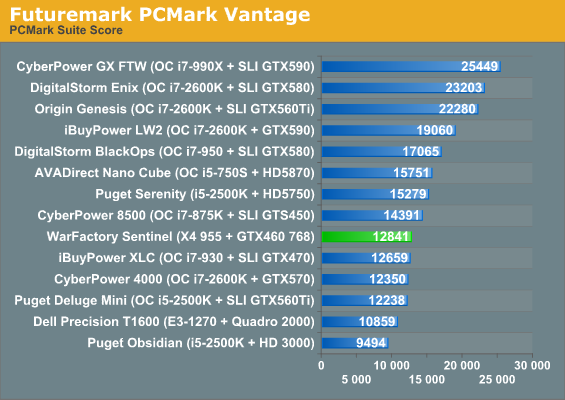
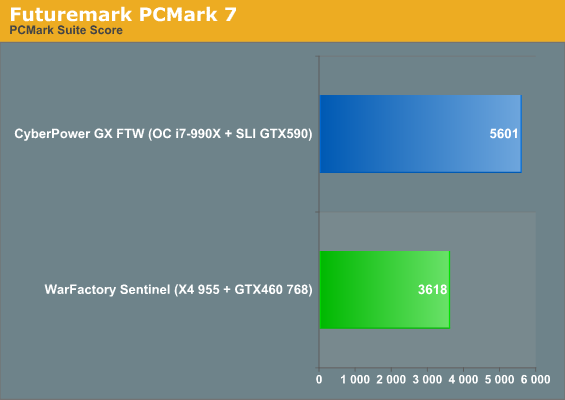
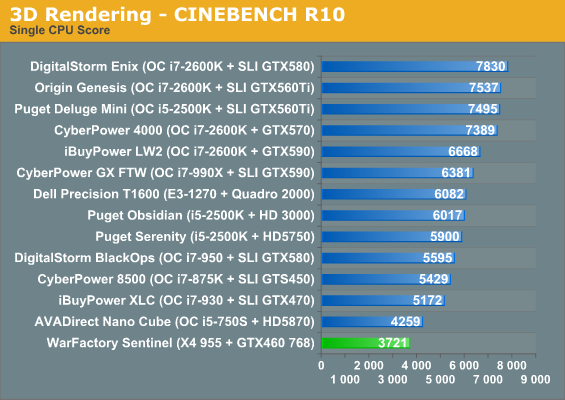
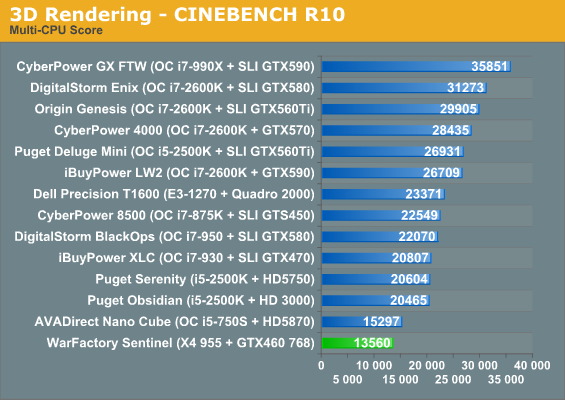
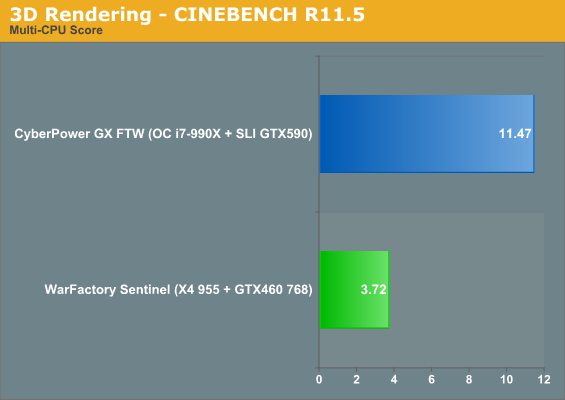
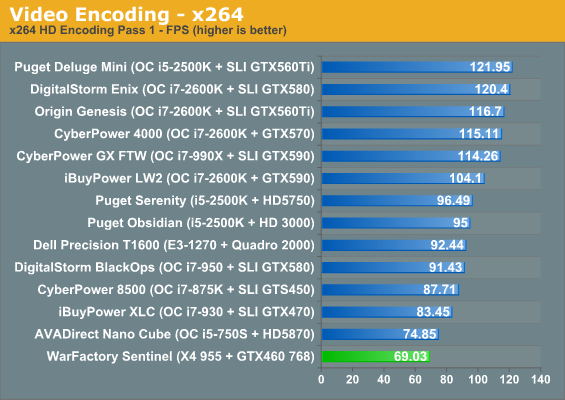

The essential problem has been for some time that the Phenom II just isn't competitive with Intel's Nehalem architecture, much less any of their succeeding high performance architectures. Try to put things in perspective, though: the Sentinel is competing with substantially more expensive systems, all of which utilize Intel's best and brightest and oftentimes overclock them. Price-wise the chip competes with Intel's dual-core offerings, essentially offering four cores where Intel would offer you two, though there are certainly areas where the Intel cores come out on top (e.g. the X4 955 places last out of all tested CPUs in the single-threaded Cinebench result).
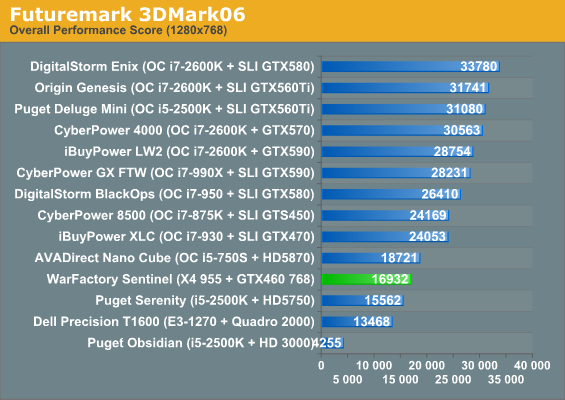
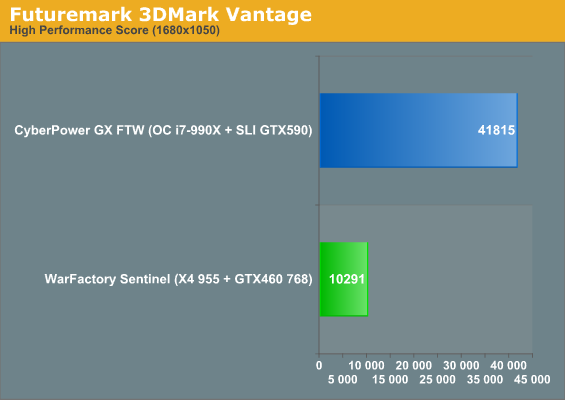
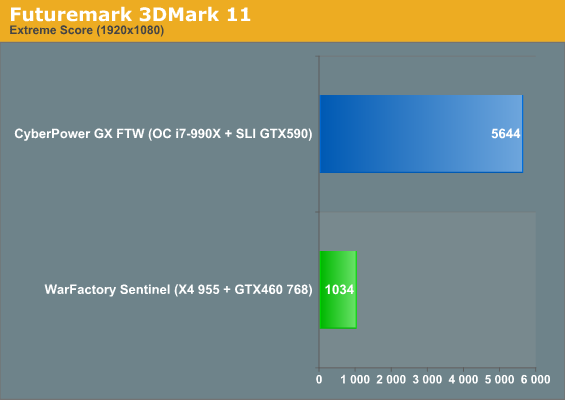
Unfortunately the SLI GTX 590 rig is our only comparison point for 3DMark Vantage and 3DMark 11 presently, and that's not exactly a fair fight. That machine has nearly a kilowatt worth of performance behind it and sells for five times what the Sentinel does. Put in perspective in 3DMark06, the Sentinel looks a lot better and provides a reasonably competitive gaming experience. Futuremark isn't everything, though; let's see how the Sentinel handles in real world gaming scenarios.










37 Comments
View All Comments
TrackSmart - Thursday, June 9, 2011 - link
Yes, but the Dell would come with a 250 Watt no-name powersupply and the world's worst $20-equivalent case. And if you care about gaming, the graphics card is a bigger bottleneck than the CPU, so the 5770 would make the system about 20% slower for gaming (my rough guess). And the SSD, though tiny, will make all normal computing tasks much snappier, even if it is too small for games. And it comes with a lifetime warranty. How much would Dell charge if you wanted even a 3 year warranty?In sum, I'd still take this over the Dell any day (assuming I had to buy pre-built)
frozentundra123456 - Thursday, June 9, 2011 - link
I know the power supply is more than 250 watts. Dont be ridiculous. In fact I think they upgraded it to around 430 watts. Any you may be right that a SSD makes the computer faster in day to day use. But to me this is a PC that is supposed to get maximum gaming performance per dollar. I dont think an SSD fits into that build.And I still dont think it makes any sense to buy a gaming PC with an old tech processor that has been outclassed already twice by Intel and with another refresh coming out soon (Ivy Bridge) that will make it even more obsolete.
Lazlo Panaflex - Wednesday, June 8, 2011 - link
"The only questionable decision I feel like they made was the use of G.Skill instead of a more reputable brand like Kingston or Corsair or Crucial"I call shens here. Why do you think G.Skill is a less reputable brand? I've bought a lot of G.Skill over the years, and they're *extremely* reliable. Never had any fail on me, and they have a lifetime warranty just like your other "reputable" brands. I doubt people are rushing out to buy Crucial Ballistix these days.
Klober - Wednesday, June 8, 2011 - link
I was going to post the same thing until I read Lazlo's post. I have had several kits of G.Skill and have never had any problems, and this is while running the kits well above specs. As you mentioned in the beginning of the review, inexpensive does not equal cheap and this applies to G.Skill as well.And for reference, I have had Crucial Ballistix Tracer DDR2 memory - 2 2x1GB kits - and one stick out of each kit was bad which doesn't say much for the "reputable" brand. Yes, I was able to get them replaced with no cost to me except shipping, but that is no less than any other RAM manufacturer does these days.
Also, as an added thought, considering AnandTech uses G.Skill in their motherboard test configurations (G.Skill RipjawsX DDR3-2133 9-11-9-28 4x4GB Kit, 1.65V) playing them down as a lesser manufacturer is probably not in the best interest of the site. I've been coming here for years and think AnandTech has the most thorough and unbiased reviews out there - so I'm not going anywhere - but this could turn away newcomers to the site which would be unfortunate.
mfenn - Wednesday, June 8, 2011 - link
Thirded.G.Skill is reliable, well-priced memory. What's not to love? Oh, that's right, they don't have to inflate their prices to pay for advertising.
Nfarce - Wednesday, June 8, 2011 - link
Fourthed. My last two heavy overclocked rigs have had G.SKILL: 2x2GB of DDR2 1066 in an overclocked E8400 rig running at 4.4GHz two years ago, and more recently 2x4GB Ripjaw DDR3 1600 in a Sandy i5 2500k running at 5.0 GHz. Anyone who thinks G.SKILL is a lower end brand is less knowledgeable than he thinks.Liquidchild - Wednesday, June 8, 2011 - link
I don't want to hear that who every would buy this DOES NOT WANT to build it themselves...this stuff costs 760 dollars on newegg. If you search some more I bet you could hit 700 even. If you don't know how to build a PC, pay the kid down the street to do it for 150 bucks and he will cream his pants. Its easier to build a PC then it is to pass a 11th grade tirg test, so don't even give me the "a kid is not a computer building business, its too hard for him".mrcaffeinex - Wednesday, June 8, 2011 - link
I build computers for people all the time and this is right in line with several that I have built. I am a big fan of the HAF 912 and use one for one of my personal machines, in addition to several builds for customers. As several others have mentioned, I would have preferred to see a better CPU/GPU in this build, but ultimately for the budget gaming crowd there is nothing wrong with this machine. I view these types of systems as WoW boxes more often than not, but as the review demonstrates, you can play a variety of games at solid framerates.While the manufacturer is new to the game, they are standing behind their product, in my opinion, with their lifetime warranty. Overall, for the price, G.Skill memory is a good value, and have a lifetime warranty as do many other major memory manufacturers.
As far as the markup, it makes sense to me: 1) they are offering a lifetime warranty, 2) they are using great quality components and the one most people don't consider, 3) they deserve a couple bucks for their knowledge and time spent in assembling this type of machine.
There is a huge market out there full of 'users' that are not 'builders'. They do not know the first thing about building a gaming computer, but they have money to spend and will buy whatever pops up as a result of their Google search for 'gaming computer'. At least if they buy one of these they shouldn't feel like they've been fleeced.
Midwayman - Wednesday, June 8, 2011 - link
Including a SSD is a strange choice for a budget system. While you can get immense gains from it, I'd rather see a better CPU, or at least pay a little more for a usable SSD. I personally wouldn't bother until I can get to the 80-90 gig level for a SSD. You get all the hassle of having split user directories, but not enough space to really reap the benefits of installing most of your apps on the drive.jabber - Thursday, June 9, 2011 - link
I build all my budget systems with a 60GB SSD now.Ok not gaming machines but I pair the Athlon II 3Ghz dual core with a SSD in a budget box and folks (ahem) "cream their pants" when they get it home.
I mention to folks they will be getting a 60GB HDD and if they question if its large enough I ask them to right click on their C: drive and tell me how much space they have used on their 6 year old PC. They rarely have used more than 30GB.
If their older system had a decent sized SATA HDD (160GB+) I will install that as a second drive for no extra cost.